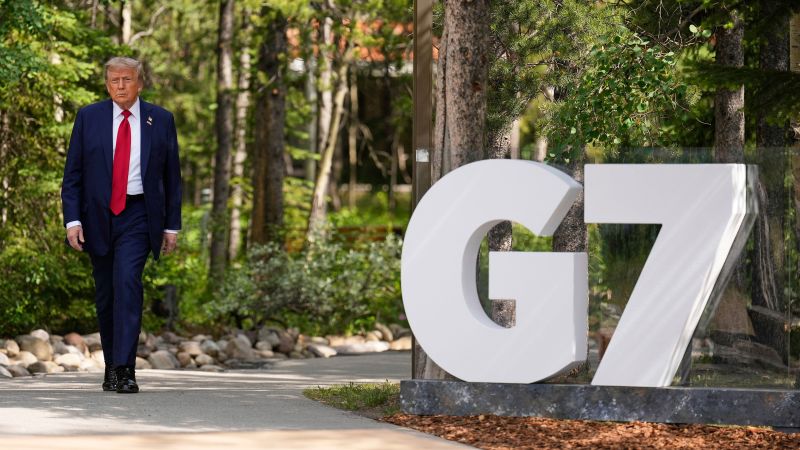On a recent Monday, President Donald Trump made a swift decision to leave the Group of 7 (G7) summit held in the picturesque Canadian woods, citing security concerns. It all started with a few hours of diplomatic engagement before Trump found the setting less conducive for his purposes. Specifically, he expressed a preference for the quieter confines of Washington over the rustic backdrop of Alberta, where the summit was taking place.
Upon taking an overnight flight back, Trump attributed his sudden departure to operational security, indicating that he was wary of being eavesdropped upon during his conversations with fellow world leaders. His skepticism of communication methods was evident as he declared, “I don’t believe in telephones, because people like you listen to them,” addressing reporters aboard Air Force One. His inclination toward face-to-face discussions rather than remote conversations reflects a distinctive approach in global diplomacy, especially when critical national matters are at stake.
However, Trump’s early exit was not fully aligned with the summit’s agenda. For the G7—the first international conference of his second term—there were several conversations and decisions that his counterparts had mapped out, and tensions arose when he criticized an eleven-year-old decision to exclude Russia from the G7 framework. After returning to Washington, he appeared ready to engage with national security advisors in the White House Situation Room to discuss the escalating conflict in the Middle East. Trump, as he disclosed while flying home, was seeking a “real end” to the conflict, suggesting a strong stance against Iran while downplaying any desire to negotiate ceasefire terms.
As the summit progressed, Trump’s vice president hinted on social media that further U.S. actions to curb Iranian enrichment might be possible, which indicated a potential escalation in U.S. involvement in the already volatile Israel-Iran situation. Trump’s posts on Truth Social portrayed a more aggressive posture toward Iran, heightening his rhetoric with a call for “UNCONDITIONAL SURRENDER!” This situation unfolded against the backdrop of his retreat from G7 discussions.
Interestingly, despite claiming urgency as a reason for his departure, Trump’s subsequent comments indicated a belief that clarity regarding Israeli intentions would emerge within the subsequent two days, hinting at a lack of urgency that contradicted his explanations. Observations from the summit suggested that Trump valued individual decisions over collective actions, leaving his foreign counterparts navigating a complicated path to consensus on pressing issues, such as the Israel-Iran conflict.
The day prior, European leaders were struggling to solidify a joint statement advocating de-escalation between Israel and Iran. Resistance from U.S. officials had altered the tone of the statement. Yet, by the leaders’ dinner, which coincided with Trump’s abrupt announcement of his early departure, a compromise had formed, allowing Trump to agree to a diluted version of the document.
Trump’s preferences for shorter, informal dialogues were taken into consideration by summit organizers. Leaders opted for an agenda that included less formal group sessions, allowing more time for one-on-one discussions, thereby reducing the chances of Trump disengaging due to overwhelming tedium. This flexibility was essential as European officials believed keeping Trump actively engaged was critical to avoiding diplomatic blunders.
Trade discussions, which Trump expressed keen interest in, notably included renewed conversations with European Commission President Ursula von der Leyen. A misstep occurred when Trump mistakenly claimed he was showcasing a new trade agreement with the EU, prompting humorous retorts from British Prime Minister Keir Starmer. However, none of these interactions became compelling enough to retain Trump in Canada.
By midday, signs of Trump’s restless disposition became apparent to his aides. Even amidst the cordial interactions and celebratory acknowledgments from world leaders, including birthday wishes and gifts, including a signed soccer shirt from Cristiano Ronaldo, Trump’s thoughts remained fixated on the turmoil in the Middle East. As Trump departed from the summit, he conveyed a sense of urgency that transcended diplomatic pleasantries, leading to a complex dynamic in his relationships with global counterparts.
While departing, leaders like Canada’s Prime Minister Mark Carney expressed gratitude for his presence and understanding regarding his early exit, framing it as a positive sign for potential negotiations. French President Emmanuel Macron, on the other hand, regarded Trump’s departure as indicative of possible openings for further dialogue regarding a ceasefire. Trump, however, dismissed such interpretations, reframing the narrative in line with his usual keen critique of Macron.
As Trump’s aircraft took off from Calgary, the geopolitical landscape remained tumultuous, with significant figures like Ukrainian President Volodymyr Zelensky poised to meet with him, albeit with timing that would ultimately preclude their paths from crossing. This sequence of events highlights the complexities of Trump’s international engagement style and underscores the myriad ways individual leaders’ preferences can shape global discourse.



